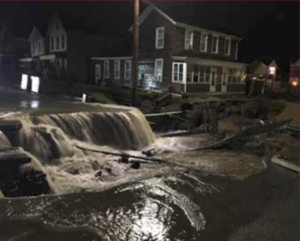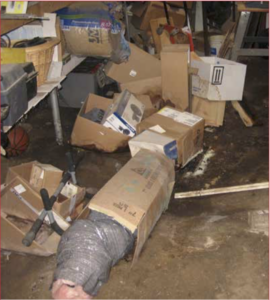Getting into Soil and Water 2020

The City of Dubuque’s Bee Branch Watershed is the area hit hardest by flash flooding during significant rain events. Frequently, several feet of water inundate homes destroying water heaters, furnaces, washers, dryers, and personal belongings. Disinvestment in the flood prone area resulted in declining property values. Equally as important, were the residual effects on its residents including poor health, negative neighborhood perceptions, stress, and a general feeling of helplessness against Mother Nature.
“Nobody would put any money into their homes, and you couldn’t blame them for the simple fact that the water would ruin everything,” said Cletus Cashman, 90-year-old lifelong Dubuque resident and participant of the Bee Branch Healthy Homes (BBHH) Resiliency Program.
In 1999, the City hired a consultant to study the nature of the flash flooding. The study, called the Drainage Basin Master Plan, determined that approximately 1,150 homes and businesses were at risk of flood damage. It also recommended major infrastructure projects to eliminate risk from flood damage. In 2003, the city began working on a multi-phased, watershed- wide approach to protect its residents.
Since then, millions have been invested to slow the rate of stormwater, reduce the amount of stormwater runoff, and safely channel stormwater through the city’s North End neighborhood. Several strategies have been used including retention basins, permeable pavement systems, storm sewer capacity improvements, and daylighting one-mile of the Bee Branch Creek and its associated floodplain.
Helping watershed residents living with residual issues from flooding was the city’s top priority when applying for Community Development Block Grant – National Disaster Resilience Competition (CDBG-NDR) funds in 2014 and 2015. The grant team made the strategic move to incorporate repairs and renovations to homes in addition to public infrastructure improvements.
The application was successful, and in 2016 the State of Iowa was awarded $96 million to make flood improvements in nine watersheds as part of the Iowa Watershed Approach including Dubuque’s Bee Branch Watershed. The City received $23 million for infrastructure improvements and $8.4 million for the Bee Branch Healthy Homes Resiliency Program.
Dubuque’s approach includes right sizing public infrastructure, repairing
and renovating homes to reduce water intrusion and address damage, and family advocacy support. This triangle represents a comprehensive plan to simultaneously improve neighborhood, structural, and social resilience. Knowing this innovative approach could serve as a replicable model for other communities, the city has captured data throughout the program.
To date, BBHH has helped 200 families address water intrusion and prepare for future rain events. On average, improvements range between $10,000 – $28,000 depending on project scope and property type. The program is available to owner-occupied homes, single-unit rentals, and multi-family residential units that are located in the eligibility area and meet income requirements established by the U.S. Department of Housing and Urban Development.

Every participating household is required to visit with a BBHH advocate. They talk about any barriers or challenges the family is facing. These self-identified challenges are sorted into five categories: health, education, financial, social, and built environment. Classifying the challenges has helped evaluate gaps in services throughout the community. Disaggregating the data by subgroups such as race/ethnicity and tenant versus owner-occupied has been integral in understanding that subgroups experience different challenges and require different approaches in order to create positive outcomes.

There have been several lessons learned throughout the program. Property drainage is critical. This includes soil modifications and effective gutter and downspout systems. Keeping water away from the home is more important
than any other modification. Once inside the home, raising furnaces and water heaters off the floor as little as six to eight inches can save them from flood damage. Dehumidification with permanent high-power vent fans, sump pumps, and tuck pointing have been equally common modifications to create a drier and healthier home.
What happens upstream effects downstream. This is equally as true in urban watersheds as it is for our rural neighbors. This can be applied at all levels – from stormwater management in our streets to a home gutter system dumping water directly on an adjacent property. Part of being a good neighbor is looking at how your home impacts others. It also means checking on your neighbors during flash flood events to make sure they are safe. Hearing that neighbors are talking to each other because of the program is the greatest compliment the city can receive. Relationships among neighbors and structural improvements to both public and private infrastructure is creating greater neighborhood resilience, and the city couldn’t be more proud to tell that story.
Sharon Gaul
Grants Project Manager
City of Dubuque